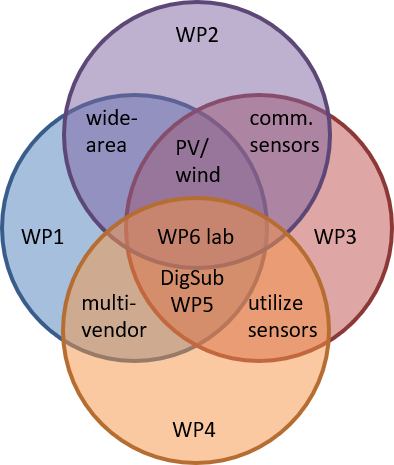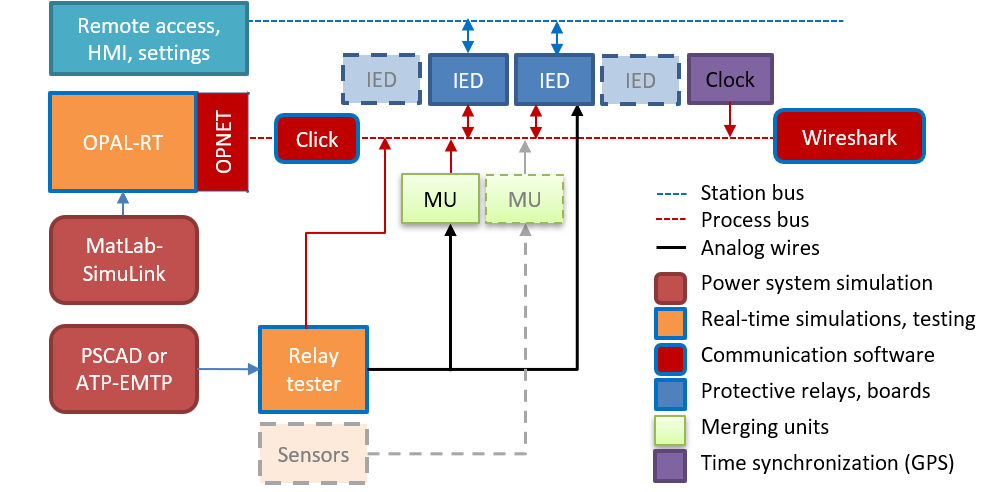ProDig
Power system protection and control in digital substations
Background
Substations are critical nodes in the power system and consist of lines, transformers, generators, compensation equipment, switchgear and instrument transformers. In a substation, the power system is controlled and protected. The term digital substation describes a technology where classical copper wiring between instrument transformers, switchgear, protective relays and control equipment is replaced by a process bus Ethernet cable. The main advantages are smaller footprint (reduced wiring, and buildings), easier expansions (plug&play), simpler documentation and engineering and possible faster future upgrade. The challenges are related to the fact that this is new, unproven technology with new competence needs. Test pilots of digital substations are now being installed world-wide.
Content
The project is a cooperation between the NTNU departments Electrical Power Engineering and Information Security and Communation Technology, UiO Dept. Technology Systems, SINTEF Energy Research and Michigan Technological University. The project is organized in 7 work packages. It will employ four PhD students and one PostDoc. The development of mutual understanding between the Power System and Telecommunication sectors is essential in the project and extensive communiction and synergies between work packages are expected.
 |
The figure shows the relation between work packages. The project will employ 4 PhD students in total under work packages 1-4. The four students will cooperate on the boundaries and synergies will emerge. WP1 and WP2 will cooperate on wide-area protection and inter-substation communication (IEC61850 extensions). WP3 and WP4 will cooperate on utilization of new sensor technologies in protection and fault location. WP1 and WP3 will cooperate on inverter interfaced renewables in transmission and regional grids, WP2 and WP3 will cooperate on communication solutions between sensors and control centers. All four PhD students will share the relay laboratory facilities. A Postdoc will be employed to work in WP5 and digital substation test procedures, and help to coordinate the four PhD students’ laboratory work. |
Methods
The project is centered around the relay protection laboratory at NTNU equipped with real-time simulators, relay testers, modern relays on process bus, and other digital substation equipment as merging units, station clocks, process bus switches. Real-time simulation (hardware-in-the-loop testing) and implementation of algorithm on microprocessor boards with IEC 61850 capabilities will be central. There will also be standard transient simulations, co-simulations (of communication and power systems), analysis of communication flows and full scale testing in the high current lab.

NTNU members
-
Poul Einar Heegaard Professor
+4799286858 poul.heegaard@ntnu.no Department of Information Security and Communication Technology -
Andrzej Holdyk SINTEF
-
Hans Kristian Høidalen Professor
+47-73594225 hans.hoidalen@ntnu.no Department of Electric Energy -
Øivind Kure University of Oslo
-
Bruce Andrew Knut Mork
bakmrk@gmail.com Faculty of Information Technology and Electrical Engineering -
Bruce A. Mork Michigan Tech
-
Rizwan Rafique Syed
+4796734128 rizwan.r.syed@ntnu.no
Partners
The consortium agreement opens up for new financing partners to join. Contact the project manager Hans Kr. Høidalen.
Private web-page (e-room) available here. Use the Microsoft account connected to your official email address.
